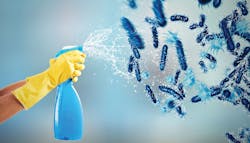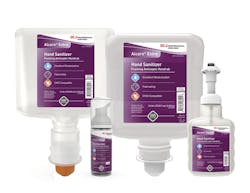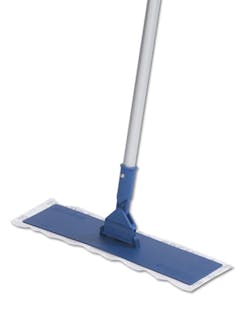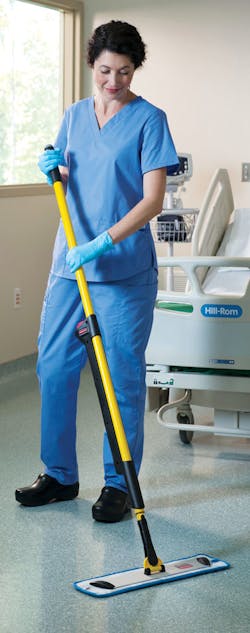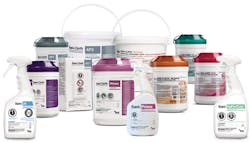In the hospital setting, there is perhaps no more important collaboration between departments than infection prevention (IP) and environmental services (EVS). They work in tandem for safer conditions for patient and staff alike.
The infection-prevention perspective
Campbell believes collaboration between IP and EVS is progressing well, “but it really is dependent on the efforts of both departments. When an equal partnership is formed, and both work together with the common goal of providing education and support to the EVS staff, it becomes an environment that decreases the risk of infection, with the patient’s safety as its focus.”
As for which department should take the lead, Campbell espouses an egalitarian viewpoint, saying, “It really doesn’t matter who reaches out first, only that the effort is made.”
The environmental-services perspective
No longer is the EVS worker on the periphery as only a janitor. As the importance of the role of EVS in preventing infection was recognized, the science behind their work bumped up their status to being important and valued members of the IP effort.
Some of the advancements Jensen mentioned are ultraviolet (UV) disinfection, spray and misting technology, and chemical advancement for reduced kill times and improved efficacy. “Chemical providers have embraced utilizing IPs as a part of their development teams and sales force in providing insight into chemical efficacy and effectiveness against microorganisms,” stated Jensen. “AHE has also championed this cause by inviting IPs into their organizational education process provided to their members, as well as in creation of their Certification for Mastery of Infection Prevention.”
Any collaboration hits snags. Jensen believes the pitfalls are fewer than they once were in forming a partnership between IP and EVS. “However,’ he noted, “EVS and IP leaders having separate or varied lengths of time on the job, experience, and education can be a pitfall. If the two are not aligned in processes and outcomes, it can create different expectations for the scope of work and how those outcomes are measured. These differences can also lead to creating one-way conversations where communication about each department’s perspective and focus are not aligned.”
Jensen agrees with Campbell that efforts must be coordinated between the two departments, that it is a shared responsibility. He outlined each department’s priorities. “IP often takes the lead on evaluation of the effectiveness of the overall process used for disinfecting and ensuring a safe environment. EVS takes the lead on establishing effective processes and protocols for eradicating microorganisms in a safe manner for patients and staff, as well as identifying effective products and technologies that work safely in the environment and provide the needed efficacy.”
A recent survey highlighted the differences in perception between IP and EVS. CONTEC conducted a survey, via Healthcare Purchasing News, in August 2019, to determine the perceptions IP and EVS have of one another’s roles in the acute-care setting. Matt Schiering, Chief Marketing Officer, said they received 170 responses. Here is a rundown of what survey results revealed:
- Two-thirds (67 percent) of IPs characterized their relationship with EVS as highly collaborative and strategic, whereas four in five (80 percent) of EVS workers felt this way about their IP counterparts.
- Bigger differences emerged when asked which of the two departments put forth more of the effort to move the relationship in a positive direction. Here, 72.5 percent of EVS workers noted the relationship is 50/50, whereas only 10 percent felt that IP leads the way. In contrast, 58.5 percent of IPs noted it was a fifty-fifty partnership, with more than one third (38.5 percent) reporting that IP leads the way.
- When it comes to trusting one another in pursuit of a shared goal to prevent healthcare-acquired infections (HAIs), the parties aren’t quite aligned: 77.5 percent of EVS respondents believe that IP has total trust in EVS efforts. However, only 44.6 percent of surveyed IPs reported that they trust EVS completely, with the balance (49.2 percent) sharing that they trust EVS somewhat.
“In short, while the relationship is strong and improving, there is work to be done to close the gap in perception between the two groups,” observed Schiering.
The vendor perspective
Vendors have a role in the relationship between IP and EVS departments, because they work closely with both departments concerning products selected and used in the facility. Their interactions have led to their own observations on IP-EVS collaboration.
From his perspective as a vendor, Martin McGonagle, General Manager, Healthcare, SC Johnson Professional, said he has been “pleasantly surprised at the speed in which we’re seeing IP and EVS departments partner to protect not only patients but also healthcare institutions’ bottom lines. With entities such as Leapfrog and the Joint Commission bringing a greater focus on infection rates and environmental-cleaning practices, it’s important that IP and EVS are finding innovative ways to avoid Hospital Acquired Condition (HAC) Reduction Program penalties. There’s a broad recognition that the cost of HAC penalties and its impact on communities is going to require IP and EVS to innovate. Without innovation, goals such as lowering the amount of HAC penalties will take longer to achieve. Organizations that are open to change and trying new best practices will have greater and faster success.”
Speaking about the positive change in status of EVS he has observed in working with IP and EVS, Schiering, CONTEC, described the ongoing elevation of the role of the EVS associate as “critical to the long-term relationship between front-line hygiene workers and infection preventionists.” He said that, whereas the IP is tasked with tracking, reporting, and intervening in ‘higher-order’ infection challenges, such as central-line–associated bloodstream infection, catheter-associated urinary tract infection, and ventilator-associated pneumonia, “it has become increasingly clear that more rudimentary prevention protocols pertaining to hand hygiene and surface cleaning could be key to helping improve long-term reductions in secondary infections. Recognition that everyone—from patient and visitors to hospital staff and especially EVS workers—is part of a broader infection-prevention team is paramount to improving relationships and ensuring improved outcomes.”
All healthcare workers share the same goals of good clinical outcomes and keeping patients safe, as well as providing a satisfactory patient experience, is the viewpoint of Caitlin Stowe, MPH, CPH, CIC, CPHQ, Clinical Affairs Research Manager, PDI. “IP and EVS have a unique bond in this endeavor; a clean clinical environment provides both protection from HAIs while also driving positive patient-experience scores.” Stowe noted, “In many facilities, IP and EVS perform environmental rounds in tandem, share the same audit tools for performance evaluation, provide joint education, and report findings at the same quality metric meetings, to drive infection rates down and experience scores up.”
The financial aspect of any endeavor is always a concern. Connecting the dots between IP and EVS collaboration and the bottom line, Michelle Olsen, Senior Manager–Rubbermaid Commercial Products, Cleaning, said this from her perspective as a vendor. “The Rubbermaid Commercial Products team continues to witness transformations in the relationship between IP and EVS departments. HAI reimbursement and continued focus on the role the environment plays in infection transmission have made this interdepartmental collaboration increasingly important.
“IP and EVS professionals recognize the best outcomes are achieved when the two departments work hand-in-hand to ensure patient safety,” continued Olsen. She said this could mean personnel shadowing each other as they work. “For the IP team, this might mean cleaning alongside an EVS team member to understand their processes and challenges. For the EVS staff, this means reviewing HAI rates/data and new products/technologies with the IP team.” Olsen believes of greatest importance is the need to collaborate in securing support from the C-suite for needed products and resources.
Tips for successful IP and EVS collaboration
Healthcare Purchasing News asked for tips to ensure a smooth, efficacious, and productive working relationship between IP and EVS. Good communication and weaving their activities are a common theme.
Education and observation:
- The EVS Director should be an active member of the infection control committee where cleaning audits and surveillance are reviewed. The IP should in turn, be an active member of the environment-of-care committee.
- The IP should be a large part of the orientation, annual training, and education of the EVS staff.
- EVS and IP should round frequently, noting the cleanliness of the hospital, focusing on patient rooms, common areas, and visitor waiting rooms, just to name a few. They should also take the time to interact with staff, discuss surveillance findings and cleaning efforts, offer just-in-time education, and provide positive feedback on a job well done.
— Lorene Campbell, Kindred Hospitals, Madera, CA, and APIC
Rounding, teamwork and review:
- Joint and regular rounding of the hospital facilities and departments with EVS and IP is essential. Minimal weekly rounding, so that each area of the facility is covered quarterly, is a best practice.
- Working together in unison is paramount, so that both departments see, hear, and understand the expectation required for successes and areas for opportunities.
- Regular ongoing reviews of policies and protocols having to do with IP and cleaning/disinfection of all aspects of the hospital and healthcare environments are necessary, to provide a safe and healing atmosphere.
— Rock Jensen, Yuma Regional Medical Center, and an AHE At Large Board Member
Communication and collaboration:
- A critical factor is ensuring clear and frequent communication exists between both departments. The IP and EVS teams can collaborate on ways to improve cleaning processes, share relevant industry information from professional organizations, and discuss new product technology.
- — Michelle Olsen, Rubbermaid Commercial Products
- Strategic goals:
- Within the most successful collaborations, IP and EVS work towards shared goals.
- Meeting frequently and communicating regularly is also important, as goals and strategies tend to change over time.
— Martin McGonagle, SC Johnson Professional
Responsibilities and relationships:
- Ensure there is clear responsibility for who cleans what, when, and how often. The policies should define who has responsibility for cleaning the patient-care surface or equipment. This helps ensure compliance and drive accountability.
- Use products that make it easy for the staff to do the right thing every time. IP should support and build relationships with EVS staff as the front-line defense for preventing HAIs. Being visible, positive (even when providing feedback), and quick to praise goes a long way to establishing a great working relationship.
— Caitlin Stowe, PDI
Cleaning and infection control best practices:
- IP and EVS departments are striving for the same thing: clean, safe environments where every patient can be free from HAIs. This alignment allows teams to collaborate on IP efforts not just when infections occur but proactively, before the infection risk exists. Implementing a standardized, programmatic approach provides common ground to achieve this mutual goal.
- IP and EVS departments should work together to select the right disinfectant that is effective against the pathogens of concern and improves efficiency.
- They should use the right processes, based on best practices.
- Comprehensive training should be a priority.
- There should be an objective, accurate method to measure cleaning effectiveness, with results made available to both the IP and EVS departments, to foster collaboration and drive continuous improvement.
— Linda Homan, RN, BSN, CIC, Senior Manager of Clinical Affairs,
Ecolab Healthcare
Training and validation:
- Establishing a program that includes training and validation is the key step to successful collaboration. Once there is agreement on the program, the rest falls into place.
- Since studies show that training is the number one issue in helping to prevent HAIs, it is important to establish routine, scheduled training for EVS staff.
- We recommend staff training be reinforced through verification and validation of cleaning procedures on a routine basis. These validation checks help identify areas where they can improve, creating an overall safer environment for both patients and cleaning staff.
- When training and processes are well documented, EVS staff have the required data to identify and collaborate on areas for improvement.
— Cali Sartor, Spartan Chemical Company, Inc.
Tools that support IP and EVS common objectives
Cleaning products and tools, along with best practices, are part of the equation in a successful IP and EVS partnership. McGonagle, SC Johnson Professional, related their philosophy. “As manufacturers, we need to bring new solutions that help our customers protect our communities. SC Johnson Professional offers products that set a higher standard to reduce HACs, and a critical aspect is providing our customers the ability to use our products in an appropriate fashion.”
“The environment is a primary, and often unexpected, source of infection,” said Alice Brewer, MPH, CIC, Clinical Affairs Director, Tru-D Smart UVC, a PDI Company. “Adopting a comprehensive, layered approach combining traditional hard-surface disinfection with total-room terminal disinfection is key.”
Brewer talked about Sani-Cloth, which she described as a clinically-advanced and fast-acting disinfection wipe. She also highlighted recent product innovations Sani-24 Germicidal Spray, which offers continuous active disinfection for up to 24 hours or against 96 touches, and Sani-HyPerCide Germicidal Spray, a single disinfectant protecting against HAI-causing pathogens, including C. difficile spores.
Homan noted studies have shown that patient rooms previously occupied by a patient with C. difficile increase the risk of transmission to subsequent patients, and patients infected or colonized with C. difficile continue to shed spores into the environment even after their symptoms have subsided. “This makes daily cleaning of patient-care areas an important prevention strategy. Ecolab’s consultative service provides on-site training to staff on safe product use and efficient workflows so that hospitals can count on consistent, effective cleaning results.”
Sartor, Vice President of Marketing and Advertising, Spartan Chemical Company, Inc., talked about advantages of Spartan’s environmental infection-control program, HealthCheck, which employs a three-pronged approach of training, validation, and documentation, to ensure proper environmental cleaning is achieved. Spartan’s CleanCheck is a web-based, multilingual training system that educates staff on cleaning standards and methods. “CleanCheck procedure cards reinforce the training program and provide a framework for adherence to the standard,” explained Sartor. “This process is supported by Spartan’s CompuClean mobile-app quality-inspection tools, which enable EVS managers to train and assess staff cleaning operations. EVS managers can then document activity to track and verify program progress and identify areas of concern.” Sartor said when used in combination with Spartan’s cleaning and disinfecting chemicals, “the system provides an end-to-end solution for environmental cleaning for health. The program complies with Joint Commission requirements for a quality-assurance inspection program and helps to boost Hospital Consumer Assessment of Healthcare Providers and Systems scores.”
Conclusion
Homan, Ecolab Healthcare, observed that EVS is “increasingly recognized for its vital role in healthcare infection prevention. While there may be just a single person designated as the infection preventionist in a hospital, the work of preventing infections is a whole-hospital effort. The IP and EVS departments bring unique knowledge and skills to the table, and they are most effective when they work together as a team.”
About the Author

Susan Cantrell
Susan Cantrell is Infection Prevention Editor for Healthcare Purchasing News.
